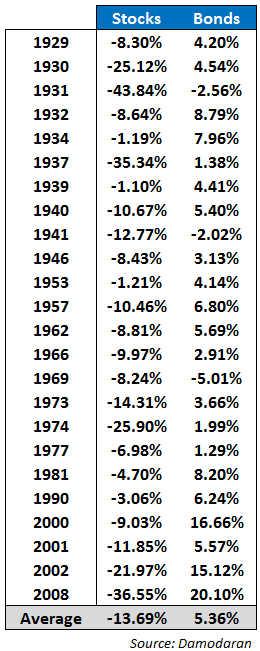Following the 2007-09 financial crisis, many investors decided they needed insurance on their portfolio to protect against the possibility of another “black swan” event and poured money into a host of new funds that were supposed to help if there was another downturn — long/short funds, tail risk strategies, absolute return funds, option hedging strategies, tactical asset allocation funds and the like – but they missed the idea completely. They were trying to plan ahead for uncertain events that could surprise everyone. Of course this is impossible, because you can’t hedge out the risks of unknown events – they’re unknown after all. [So how should an investor protect oneself from another such occurrence? The answer is below.]
protect against the possibility of another “black swan” event and poured money into a host of new funds that were supposed to help if there was another downturn — long/short funds, tail risk strategies, absolute return funds, option hedging strategies, tactical asset allocation funds and the like – but they missed the idea completely. They were trying to plan ahead for uncertain events that could surprise everyone. Of course this is impossible, because you can’t hedge out the risks of unknown events – they’re unknown after all. [So how should an investor protect oneself from another such occurrence? The answer is below.]
So says Ben Carlson (awealthofcommonsense.com) in edited excerpts from his original article* entitled Your Very Own Black Swan Strategy.
[The following is presented by Lorimer Wilson, editor of www.munKNEE.com and may have been edited ([ ]), abridged (…) and/or reformatted (some sub-titles and bold/italics emphases) for the sake of clarity and brevity to ensure a fast and easy read. This paragraph must be included in any article re-posting to avoid copyright infringement.]
Carlson goes on to say in further edited excerpts:
[The answer is bonds – yes, bonds! Why bonds? Because in years when stocks have negative returns bonds almost always show positive returns.] Since 1928, the S&P 500 has suffered 24 down years on a calendar basis, a hit rate of roughly 30%. Here is a table with each one of those losses along with the return for the 10 Year Treasuries during the down years:In 21 out of the 24 years that stocks fell, bonds rose while outperforming stocks by an average of 19%….[but, while] bonds have done their job [over the years]….stocks still rose 7 out of every 10 years and dominated bonds in overall performance over that time frame, so you can’t completely give up on equities just because they lose money sometimes.
Even though interest rates are low and bond investors can’t expect huge returns going forward, bonds can provide a diversified portfolio the following attributes:
- Bonds can act as an insurance policy against poor economic conditions such as a crisis or deflationary period. Investors flock to high quality bonds during times of unrest.
- Bonds will be your dry powder to purchase equities during the periodic selloffs in stocks. The crash marked down stocks a great deal in price, but it didn’t matter if you didn’t have any cash to put to work.
- Bonds can help you sleep at night as a way to decrease your risk. This is probably the most important attribute for bonds. They add to your emotional diversification by allowing you to create a balanced asset allocation that you can handle based on your personal risk tolerance.
Following the crash there was also a steady stream of people claiming that diversification was broken. This never made any sense to me. Bonds did their job by providing stability in the face of an economic collapse [while] stocks…got slaughtered – but eventually came back to life once everyone wrote them off for good. This is how the investing cycle works.
*http://awealthofcommonsense.com/black-swan-strategy/
[Editor’s Note: The author’s views and conclusions in the above article are unaltered and no personal comments have been included to maintain the integrity of the original post. Furthermore, the views, conclusions and any recommendations offered in this article are not to be construed as an endorsement of such by the editor.]
Related Articles:
Could U.S. Treasuries be the best performing asset class of the next one-two years? It’s quite possible. I am sure this article is bound to stir up controversy, but I’d like to spend some time analyzing several drivers that could buoy bond prices in the coming months. Words: 1053 Read More »
2. The Lessons Learned from 2008 Will Maximize Returns and Protect Your Assets This Time Round
My 3 favorite barometers for gauging investor sentiment in order to predict market outlook…are SPY as a proxy for U.S. stock markets…GLD as a proxy for commodities and TLT as a proxy for U.S. bonds, and when these 3 markets make big moves, it´s time to pay attention to what they´re saying. [Let’s review] how these 3 markets reacted during the crisis of 2009-2009 and then compare them to current market conditions. [Doing so] can give you an edge to be better positioned for the rest of this year. Words: 972
3. Bonds Are NOT a Safe Place to Be – Here’s Why
For those who think bonds are a safe place to be, you might want to reconsider. In addition to rising sovereign risk (yes, for the U.S. as well as other countries), there is interest rate risk….[should you not] hold it to maturity. If interest rates rise, then the value of your bond falls (Bonds can produce capital gains/losses, just like stocks.) and the possibility of interest rates rising is pretty good. Words: 530
4. With Options So Limited Where Should We Invest?
The fear factor among investors is high with investors unsure just where to put their money. Let’s review the options and come to a conclusion as to where best to invest our cash at this point in time. Words: 402
5. These Bonds Yield 7 – 9%: Are They Worth the Risk?
Buying bonds that insure against the extremely unlikely possibility of a specific catastrophic financial event can prove to be a very profitable investment and an ideal portfolio diversification move. I’m talking about cat bonds. Here is probably the first article you have ever read on the subject. Enjoy! Words: 821
6. Foreigners Beware: U.S. Treasury Maturity Dates are Alarming
While many investors want to believe that U.S. treasuries are a safe haven, I will use this article to debunk that myth with plain hard evidence…[to support my contention that] holding U.S. bonds is the worst investment going forward. Words: 500
 munKNEE.com Your Key to Making Money
munKNEE.com Your Key to Making Money



